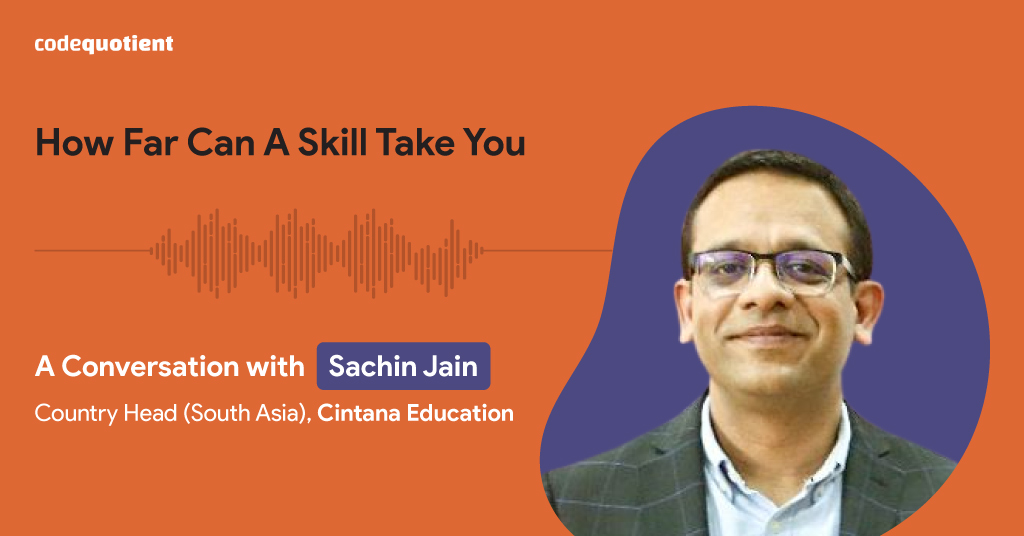In this era of fast-paced developments, changes happen across industries in the blink of an eye. Millions of job aspirants find their skill sets inadequate or outdated even before they enter the formal workforce. What can institutions and universities do to equip their learners to become market-ready?
In this episode of Fixing The Bug, our host Shivangi has a deep conversation with Mr. Sachin Jain, Country Head of Cintana Education, where he explains the role of universities and institutions in molding learners’ capabilities to fit the industry needs. He also speaks about the avenues for the Indian higher education system and describes in detail the prospects and challenges for technology in developing the educational sector.
Here are a few excerpts from this interview.
Opportunities of the Indian Higher Education System
Mr. Jain opens the dialogue by explaining a fundamental aspect that affirmed his trust in the education industry- the potential for affecting a positive social impact.
He explains the opportunities for Indian higher education to grow to the No. 1 position in the world by advancing quality education to a broader spectrum of learning aspirants. In India, the graduation rate (GR) from school to college is 27%, meaning approximately only one out of four students makes it to college programmes. But if growth happens as the government envisions, in the next 15 years, there will be 67 million learners in India, placing us above China in the global market. For this to happen, more and more people require affordable access to quality higher education.
How to Increase the Outreach of Higher Education
The government introduced the New Education Policy (NEP) in 2020, which accepts online learning as a viable solution for making education more accessible. This is a boon for people who want economic means to attain higher education.
Another way is to assist the universities in growing by expanding their pedagogy and improving the quality of education they offer. In terms of policy formulation, the Government is doing a lot to close the huge gap in outreach. But for these measures to impact student engagement and GR, they need to take shape and spread out to all areas of education.
Online Education: Prospects and Hurdles

Online learning mode was considered an inferior option until the onset of the pandemic. When it was initially introduced in India, the quality of the learning output was limited. But the situation is slowly changing now. Some of these programmes are designed with superior engagement elements, enabling the learners to interact effectively with their peers and faculty. Such capabilities elevate online learning to the level of face-to-face learning.
Gen Z learners adapt well to technology and look for digital solutions even for their basic problems. Technology will function as an enabler rather than a teacher replacement in education. The system is going to be a blended model where automated learning exists along with offline classroom teaching. Now, universities and students are trying to find a correct mix and balance between the two.
Cintana Education, in partnership with Arizona State University, is committed to assisting select universities across the globe to scale new heights by providing access to world-class academic and non-academic resources.
Four Pillars of a Knowledge Enterprise
Mr. Jain mentions four parameters that make a good university a knowledge enterprise:
1. Reputation through ranking and accreditations: Accreditations include national and international, without which a university will remain a regional one.
2. Comprehensiveness: Diversity is needed in both range and spectrum of programmes offered.
3. Internationality: Universities must provide a cosmopolitan environment and experience for their learners. This could be through student exchange programs, faculty exchange programs, semester abroad programmes, or by adopting content and curriculum at par with international standards.
This is especially important for India, which receives around 50,000 international students annually. We have a very good advantage in terms of lower cost of education, and our universities must build on that edge by creating a global learning experience.
4. Significant focus on research, innovation, and entrepreneurship: These three areas are critical for education and skill development.
These four pillars are the foundations for universities to build sustainable educational growth. The absence of one will cause the entire facade of quality education to collapse.
Enabling the Learner: Role of Institutions
Institutions and universities are two-way marketplaces. On one side of the road are the students, and on the other are different stakeholders like recruiters, the Government, and other partner institutions. The universities must do research and find out what skills the stakeholders require in their talent pool at that moment.
They must also understand what expertise their learners have or lack as strengths. The feedback from these interactions should get converted as interventions or new introductions in their curriculum.
“Arun is trying to reach that gap in the curriculum in existing programs, by enhancing skill set output.”
Click here to read tips from our founder, Mr. Arun Goyat, on how to be job-ready in a fast-changing market.
Summing Up the Key Points
In this in-depth talk, Mr, Jain provided some key insights that point toward a need for a mindset change among educators, learners, parents, and society in general, such as,
- Educational institutions need to change their approach from being curriculum-centric to learner-centric.
- Universities should generate job-creators together with job seekers. Students must be given space to experiment and gain experience while in college. This includes encouraging entrepreneurial efforts.
- Success has many facets. It is not just about getting a high-paying, white-collar job. Working in a start-up, or doing research is also a success.
- Provide those exploring such opportunities with a safety net, like a deferred placement program, if they need placement assistance.
- A formal university degree and skill-building programmes are not mutually exclusive. A degree is a basis on which learners build their further skills.
Skill development should be a continual process. Universities need to become proactive and plan their student journeys in delivering pedagogy, creating student experiences, and industry interactions.




